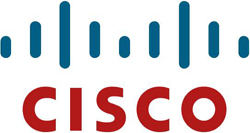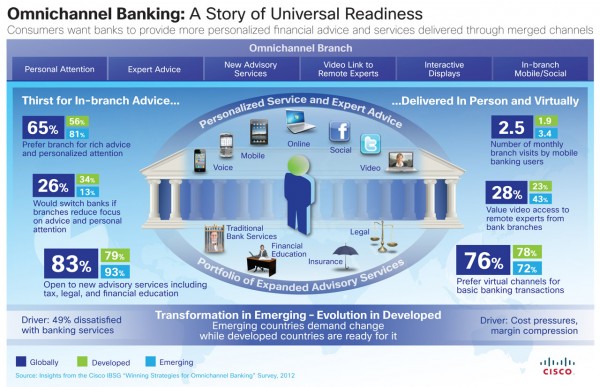Die vier wesentlichen Säulen für das Bankgeschäft der Zukunft sind (neue) Filialen, Mobile, soziale Netzwerke und Video.
Cisco today announced findings from the Cisco IBSG Omnichannel Banking Study of 5,300 consumers in five developed countries (Canada, France, Germany, U.S. and U.K.) and three emerging countries (Brazil, China and Mexico). The study shows consumers want banks to deliver financial advice and banking services through both virtual and physical channels, ushering in a new era of omnichannel banking that provides customers with services in a manner most convenient and personalized to their needs.
To address the omnichannel banking trend, Cisco also announced the Cisco® Remote Expert Smart Solution for Retail Banking , which helps enable virtual face-to-face meetings via high-definition video between customers and specialty lending, wealth management and other types of banking advisers — from any bank branch, in real time. Cisco Remote Expert for Retail Banking helps enable banks to maximize the efficiency and productivity of financial services advisers so they can capture customer business at first contact, providing the personalized customer service the customer desires.
Banks are operating in a challenging environment of rapid economic change, more technology-savvy customers, thinner margins and increasing regulations. Many banks are looking to adopt an omnichannel banking strategy to optimize their retail channels based on customers‘ preferences to offer more personalized financial services.
The Cisco Omnichannel Study was designed to discover consumers‘ attitudes and preferences towards different channels, both physical (in person at a bank branch) and virtual (mobile, online, video conference, social media, etc.). The study also recommends strategies for banks to implement that will drive profitability and increase customer satisfaction. The research included the testing of several innovative banking concepts that address alternatives within the branch model and new strategies for virtual models.
Omnichannel Research Highlights
Despite the popularity of virtual banking, global consumers still value bank branches for personal attention and favor expanded services that include different kinds of financial advice – creating opportunity for the omnichannel branch.
- Consumers globally rejected the idea of highly automated branches with limited personal attention and expertise, with 26% consumers saying they would leave their current bank if personal attention and advice were eliminated from their bank branch.
- 65% of respondents globally (56% in developed countries and 81% in emerging countries) would be in favor of bank branches that offered an expanded portfolio of financial and advisory services (financial education, legal, accounting, tax, and insurance).
- Overall, consumers want to use all the options available to them across physical and virtual channels. Frequent users of virtual channels also visit branches more frequently, with 30% of users of virtual banking channels also being frequent branch visitors (2+ visits per month).
- 45% of consumers strongly favor a total virtual banking alternative over one where they’d use highly automated branches with limited advice or personal attention (23%).
Consumers‘ views on other omnichannel banking reveal preferences for service specialization by channel and vary by region:
- Internet: 78% of consumers in developed markets and 72% of consumers in emerging markets prefer to use bank Web applications for paying bills, managing accounts, checking balances, and other basic transactions.
- Mobile: 13% of consumers in developed markets and 18% of consumers in emerging markets prefer to use mobile banking applications for real-time expense tracking, personal finance management (PFM) and payments.
- Video: 23% of consumers in developed markets and 43% of consumers in emerging markets saw the use of video conferencing as a way to enhance the quality of advice in situations where the access to quality expertise is a concern.
- Social: Only 1% of consumers in developed markets and 8% in emerging markets indicated a preference to use the social media channel for conducting banking transactions.
Consumers‘ concerns in protecting personal information could be a roadblock to quick adoption of omnichannel banking.
- Significant concerns about privacy, security and identity theft was prevalent among consumers in both developed markets (65%) and emerging countries (53%).
- 42% of consumers consider banks to be the most trusted stewards of their digital information, ahead of the government (19%), telecommunications companies (6%) and social media sites (4%).
- An „opt-in“ approach could remove roadblocks: 29% of consumers oppose giving complete access to personal information for value propositions; however, they will share personal information in an opt-in basis.
Quelle: Cisco
Die Studie „Winning Strategies for Omnichannel Banking“ kann hier direkt heruntergeladen werden.




